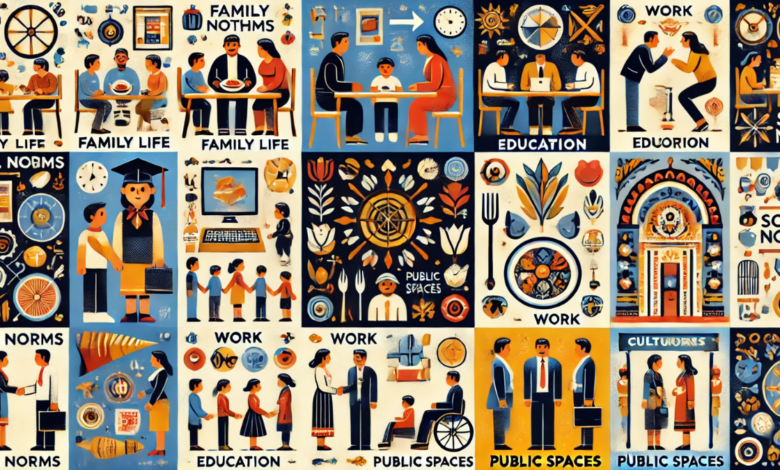Understanding Social Norms Examples and Impacts on Society

Introduction to Social Norms
Social Norms Examples are the unwritten rules of behavior that govern our interactions with others in society. These norms are shared expectations about how people should behave in specific situations and help maintain order within groups, communities, Social Norms Examples institutions. Examples of social norms are fundamental to social life at their core because they create predictability and stability in human behavior. They dictate everything from how we speak to how we dress and interact with others, whether in public or private settings.
The importance of social norms examples cannot be overstated. They provide the necessary structure to guide actions and reduce uncertainty. For instance, norms around personal space ensure we know when it is appropriate to be close to someone and when it is not. Norms also promote social cohesion, as individuals align their behavior to meet the expectations of the larger group. While social norms may be invisible, their influence is significant, shaping everything from daily habits to complex societal structures.
There are various social norms, each playing a different role in society. Folkways are the everyday habits and practices that are expected but not strictly enforced. Mores are more serious norms that often carry moral significance, such as norms around honesty and respect for others. Laws are the most formalized norms, usually backed by legal systems, while taboos are behaviors that are universally forbidden due to cultural or religious beliefs. Each type of norm is essential in its own right and contributes to the functioning of society.
Examples of Social Norms in Different Contexts
Examples of social norms are present in every aspect of our lives, from family dynamics to public spaces. In family life, examples of social norms dictate the roles and responsibilities of family members. For example, parents are commonly expected to provide for their children, while children are expected to respect their elders. Gender roles also play a significant part in familial expectations, where men and women may have different roles in raising children, depending on the cultural context. These norms create a sense of order and establish responsibilities that help families function cohesively.
In educational settings, examples of social norms dictate acceptable student behavior. For example, students are expected to raise their hands before speaking, and teachers must manage the classroom reasonably and unbiasedly. There are also norms around academic performance, such as the expectation that students will complete assignments and exams on time. These examples of social norms help maintain discipline in the classroom and establish the foundation for learning and growth.
The workplace is another domain where examples of social norms are vital. Professional attire is one of the most visible workplace norms, as employees are expected to dress in ways that are appropriate for their roles and the company’s culture. In addition, norms around communication, punctuality, and performance are critical to the smooth operation of an organization. The norms in the workplace can vary greatly depending on the industry, but they are essential for maintaining productivity and fostering a respectful environment.
Public spaces also have a unique set of examples of social norms. For example, waiting in line (queueing) is a norm in many cultures, ensuring fairness and order when accessing goods or services. Another crucial social norm example in public spaces is respecting personal space. In crowded environments, such as public transportation, individuals are generally expected not to invade each other’s space unless necessary. These norms help create a sense of civility and minimize discomfort in shared spaces.
The Evolution of Social Norms
Examples of social norms are not static; they evolve based on cultural, political, and technological shifts. A prime example of this is the changing norms surrounding gender and LGBTQ+ rights. For much of history, rigid gender roles dictated what was acceptable for men and women. However, in recent decades, movements advocating for gender equality and LGBTQ+ rights have led to a more inclusive society, where norms are becoming more fluid, and individuals are free to express their gender and sexual orientation without fear of discrimination.
Technological advancements have also played a significant role in the evolution of social norms examples. The rise of social media, for instance, has reshaped communication norms, with platforms like Facebook, Instagram, and Twitter creating new expectations for online interactions. Today, social norms examples include the idea that posting specific content on social media, such as offensive language or unverified news, is inappropriate. These technological shifts have not only changed how we communicate but also how we present ourselves to the world and interact with others.
Several factors influence the development of social norms examples. Cultural values, religious beliefs, and historical contexts shape acceptable behavior in a given society. Social movements, such as the Civil Rights Movement or the Women’s Liberation Movement, have pushed for changes in societal norms by challenging the status quo and advocating for justice and equality. These movements have led to the redefinition of many norms, highlighting the evolving nature of social expectations.
Breaking social norms can have profound effects on individuals and society. Some people may challenge norms as a protest to bring attention to injustice or inequality. In other cases, individuals or groups might break norms out of a desire to innovate or change societal structures. These acts of rebellion can lead to positive change but can also cause disruption and social friction as society grapples with new ideas and behaviors.
The Impact of Social Norms on Society

Social norms examples can have both positive and negative effects on society. On the positive side, norms help create order and predictability. For instance, norms regarding politeness, such as saying “please” and “thank you,” help maintain civility in interactions. They also foster trust among individuals, as people are more likely to cooperate when they understand the expected behaviors of others. These shared expectations also help build community and reduce conflict, creating a more harmonious environment for social interactions.
However, social norms examples can also have negative consequences, particularly when they enforce conformity and suppress individuality. For example, the norm of always being cheerful and optimistic can put undue pressure on individuals to hide their true feelings, leading to isolation or inadequacy. Similarly, societal expectations around beauty, success, and wealth can create unrealistic standards, leading to issues such as body image problems or mental health struggles. Social norms examples that exclude certain groups or stigmatize others—such as norms related to race, gender, or sexual orientation—can perpetuate discrimination and inequality.
The impact of social norms examples on mental health is particularly significant. Societal pressures to conform to specific norms can contribute to stress, anxiety, and depression. People who feel they cannot meet the expectations set by their community may struggle with feelings of inadequacy or alienation. Breaking away from harmful social norms can be a powerful way to reclaim individual identity and reduce mental health challenges, but it often requires significant courage and resilience.
Conclusion
Social norms are an essential aspect of society, profoundly shaping behavior and interactions. Social norms examples help maintain order, foster cooperation, and create a sense of belonging. However, they can also restrict individuality and contribute to societal inequalities. Understanding the evolution and impact of social norms examples allows us to navigate better and challenge them, mainly when they are outdated or harmful.
As society continues to change, so too will its social norms. Ongoing cultural, technological, and political developments will likely influence the future of these norms. It is essential to remain mindful of how social norms and examples shape our lives and strive for a balance between adherence to them and the freedom to innovate and express individuality.
FAQs
- What are the different types of social norms?
- Examples of social norms can be categorized into folkways, mores, laws, and taboos, each with varying degrees of social enforcement and cultural significance.
- How do social norms influence everyday behavior?
- Social norms examples dictate how we behave in different situations, such as greeting others, dressing, and interacting in social settings, ensuring predictability and order.
- Why do social norms differ across cultures?
- Social norms differ across cultures due to varying historical, religious, and cultural contexts, such as shaping beliefs and expectations about acceptable behavior.
- Can social norms change over time?
- Yes, examples of social norms evolve as societies change, influenced by social movements, technological advancements, and shifts in cultural attitudes.
- What happens when someone breaks a social norm?
- Breaking a social norm example can result in social sanctions, such as disapproval, ostracism, or even legal consequences, depending on the severity of the norm and the context in which it is violated.
You May Also Read: https://topblogbuz.com/resume-genius/



